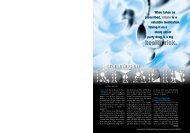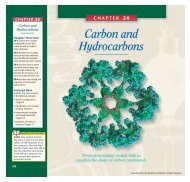You also want an ePaper? Increase the reach of your titles
YUMPU automatically turns print PDFs into web optimized ePapers that Google loves.
SECTION 9-1<br />
PRACTICE GUIDE 9A<br />
Solving for:<br />
r PE Sample, 1;<br />
Ch. Rvw. 8–9, 54<br />
PW 6–8<br />
PB 5–7<br />
m PE 2, 3; Ch. Rvw. 36<br />
PW Sample, 1–3<br />
PB 8–10<br />
F B<br />
324<br />
PE 4; Ch. Rvw. 41*,<br />
43*, 44*, 52*,<br />
53*, 59*, 63*,<br />
64*, 65*, 68*, 69*<br />
PW 4–5<br />
PB Sample, 1–4<br />
ANSWERS TO<br />
Practice 9A<br />
Buoyant force<br />
1. a. 3.57 × 10 3 kg/m 3<br />
b. 6.4 × 10 2 kg/m 3<br />
2. 97 kg<br />
3. 9.4 × 10 3 N<br />
4. a. 6.63 N<br />
b. 5.58 N<br />
Section Review<br />
ANSWERS<br />
1. A solid has a definite shape,<br />
while a fluid does not; a liquid<br />
has a definite volume,<br />
while a gas does not.<br />
2. b, c, and d<br />
3. 4.7 × 10 3 m 3<br />
4. 9.92 × 10 2 kg/m 3<br />
5. The effective density of the<br />
kayak includes both the material<br />
composing the kayak and<br />
the air <strong>with</strong>in the kayak below<br />
the level of the water.<br />
324<br />
PRACTICE 9A<br />
Section Review<br />
Chapter 9<br />
Buoyant force<br />
1. A piece of metal weighs 50.0 N in air, 36.0 N in water, and 41.0 N in an<br />
unknown liquid. Find the densities of the following:<br />
a. the metal<br />
b. the unknown liquid<br />
2. A 2.8 kg rectangular air mattress is 2.00 m long, 0.500 m wide, and<br />
0.100 m thick. What mass can it support in water before sinking?<br />
3. A ferry boat is 4.0 m wide and 6.0 m long. When a truck pulls onto it, the<br />
boat sinks 4.00 cm in the water. What is the combined weight of the<br />
truck and the ferry?<br />
4. An empty rubber balloon has a mass of 0.0120 kg. The balloon is filled<br />
<strong>with</strong> helium at 0°C, 1 atm pressure, and a density of 0.179 kg/m 3 .The<br />
filled balloon has a radius of 0.500 m.<br />
a. What is the magnitude of the buoyant force acting on the balloon?<br />
(Hint: See Table 9-1 for the density of air.)<br />
b. What is the magnitude of the net force acting on the balloon?<br />
1. What is the difference between a solid and a fluid? What is the difference<br />
between a gas and a liquid?<br />
2. Which of the following objects will float in a tub of mercury?<br />
a. a solid gold bead<br />
b. an ice cube<br />
c. an iron bolt<br />
d. 5 mL of water<br />
3. A 650 kg weather balloon is designed to lift a 4600 kg package. What volume<br />
should the balloon have after being inflated <strong>with</strong> helium at 0°C and 1 atm<br />
pressure to lift the total load? (Hint: Use the density values in Table 9-1.)<br />
4. A submerged submarine alters its buoyancy so that it initially accelerates<br />
upward at 0.325 m/s 2 . What is the submarine’s average density at this time?<br />
(Hint: the density of sea water is 1.025 × 10 3 kg/m 3 .)<br />
5. Physics in Action Many kayaks are made of plastics and other<br />
composite materials that are denser than water. How are such kayaks able<br />
to float in water?<br />
Copyright © by Holt, Rinehart and Winston. All rights reserved.
















